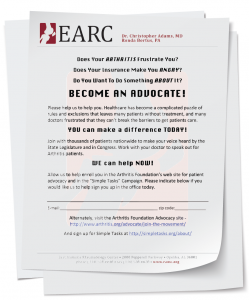
(Click for larger image)
Figure 1: Draft Call to Advocacy Letter. Note: Put this on your letterhead, scale it to fit, and edit it as you feel appropriate; this isn’t copyrighted.
The letter was created using professional design resources intended to maximize visual impact, but you should modify to fit your goals and needs. When you do, save it as a PDF to make it more difficult to modify.
Any mechanism for doing this must be simple, direct, easily implemented and unobtrusive to both the patient and the practice. The payoff for the patient may be a feeling that they are no longer pawns sacrificed in the big-stakes chess game of healthcare. The potential payoff for the doctor may be a hundred united voices, not just one, to ask for relief from bureaucratic burdens and respite from obstructionist insurance regulations.
Our efforts were prompted by recent draconian requirements for prior authorization of many medicines by our state’s leading insurance carrier. In a matter of days, we developed and implemented a mechanism for enrolling patients as advocates with the Arthritis Foundation and the Simple Tasks Campaign. In order to have this work well in your practice, lay a foundation by exploring your options and goals, then enrolling your staff in this project. Next, implement some simple steps into your usual office routine. Finally, consolidate your program by making advocacy an integral part of your practice.
Your program requires definition and limits. How much do you want to advocate? We decided to reach out to every patient at every visit, but you might set a more focused goal. The process I describe works for many patients as easily as a few. Do you want to focus on a few specific items, such as political advocacy, or do you want to just encourage patients to participate in foundations? We decided to take an aggressive advocacy route, and selected the Simple Tasks Campaign and Arthritis Foundation Advocates as our initial targets, with plans to broaden our scope to other groups later. We want our patients to be political advocates, writing their insurance companies and their legislators.
Before you get started, you might need to check with any legal advisors to be sure your state or city doesn’t have an obscure rule against your offer to enroll patients in an advocacy program. Our lawyers told us that as long it was voluntary, we were on sound legal footing.
Quick-Start Outline
Having defined your goals, here’s a suggested mechanism for encouraging patient advocacy that I have tested and implemented in my practice:
- Do your homework. Review advocacy sites for arthritis and decide which to use. Start out small, just one or two sites. We selected the Arthritis Foundation and Simple Tasks because of their broad scope and their easy sign-up pages.
- Enlist your staff. Explain the importance of patient advocacy, and how their payoff might be less bureaucratic headaches and hassles for them if we can get patients to help us change the system. Our method doesn’t involve a lot of time or effort. Make your staff advocates, too. Show them the websites for your selected advocacy group and where to sign people up.
